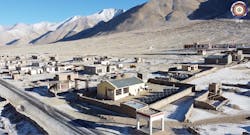Winners of 2022 Greater Good Awards offer insight into their microgrid projects: video
The fourth annual Microgrid Greater Good Awards were handed out during the Microgrid 2022 conference in June. The winners each presented their projects during a special session at the conference, which is now available to view for free.
Winners were selected by an independent panel of judges, and awards were granted for Highest Recognition for a Microgrid Serving the Greater Good; Greater Good Award for a Grid-Connected Microgrid and Greater Good Award for a Remote Microgrid.
There was a fourth category added this year for the Greater Good Award for a Local Microgrid in the conference’s host state, which for 2022 was Pennsylvania.
Pennsylvania microgrid accentuates energy efficiency
The Penn State Health Milton S. Hershey Medical Center Microgrid was recognized with the Local Microgrid Greater Good Award. In the video, Katherine Hammack, director of special projects for Green Business Certification (GBCI) and Kevin Kanoff, campus energy engineer for the Milton S. Hershey Medical Center, Penn State College of Medicine, present the details of the project to conference attendees. They explain how the microgrid, which includes combined heat and power and energy storage, has significantly improved the medical center’s fuel use efficiency.
During the presentation, Kanoff notes that “efficiency is really important. It’s the building block to the next level.” He says that in 2011 when they first launched phase 1, their total energy spend was $14 million. In 2022, their energy spend is projected to be just $6.1 million. According to Kanoff, “When you do energy efficiency, you can have a tremendous carbon reduction, but you’re doing it at a financial benefit.”
The challenges of building a microgrid at 14,200 feet
Global Himalayan Expedition (GHE) received the Greater Good Award for a Remote Microgrid for the Sato Medical Health Center in Ladakh, India. Doug Mackenzie, an expedition team member, shares how this microgrid serves seven communities in the Himalayas and made a 2021 COVID-19 vaccination program possible. Located at an elevation of 14,200 feet, Mackenzie also explains how the team overcame challenges unique to the high altitude environment.
“GHE works with local technicians to train, install, own and operate the microgrid systems,” according to Mackenzie. Assistance from GHE is available, but it can take several days for that support to arrive. This is why “the daily, weekly and monthly maintenance is all done by the local villagers,” Mackenzie says.
Advanced controller for higher ed
The Grid-Connected Microgrid Award was given to Santa Rosa Junior College (Worley, Pacific Gas and Electric, PXiSE, Center for Sustainable Energy, California Energy Commission, Go Electric). Joe Sullivan, head of sales for PXiSE, presents the project’s objective, configuration and results. The microgrid provides resilience not only to the 100-acre campus but also to the region, which is prone to wildfires and public safety power shutoffs. PXiSE supplied the microgrid controller for the project.
He explains that “the way you control the microgrid based on the objectives and the project goals is very important as to how you select a controls provider and a controls solution.”
SunMoksha helps communities rise economically
The final presentation in this video from the Greater Good Awards session of Microgrid 2022 is from Ashok Das, founder and CEO of SunMoksha Power. SunMoksha received the Highest Recognition Award for its work on the Kudagaon Village Microgrid in Odisha, India. Das explains the goals and components of the microgrid as well as how the reliable electricity it produces is enabling the island community to thrive.
Das says, “In our our projects, we’ve realized that the streetlights are a game changer because it enables social interaction. People come out to play in the night, they can have a social life and feel safe.” According to Das, this is one of the reasons that safety is a key metric they measure against when doing a project.
Socioeconomic development is also key for each of SunMoksha’s microgrid projects. Das says, “It cannot just be light” or power to improve education, but it has to empower the community move up the economic value chain.
The session is moderated by Mohammed Zadeh, vice president of ETAP, and it includes a question and answer session recorded during the live event.
Stay tuned for the opening of the 2023 nominations for the Microgrid Greater Good Awards. Subscribe to the free Microgrid Knowledge Newsletter.
About the Author
Kathy Hitchens
Special Projects Editor
I work as a writer and special projects editor for Microgrid Knowledge. I have over 30 years of writing experience, working with a variety of companies in the renewable energy, electric vehicle and utility sector, as well as those in the entertainment, education, and financial industries. I have a BFA in Media Arts from the University of Arizona and a MBA from the University of Denver.

